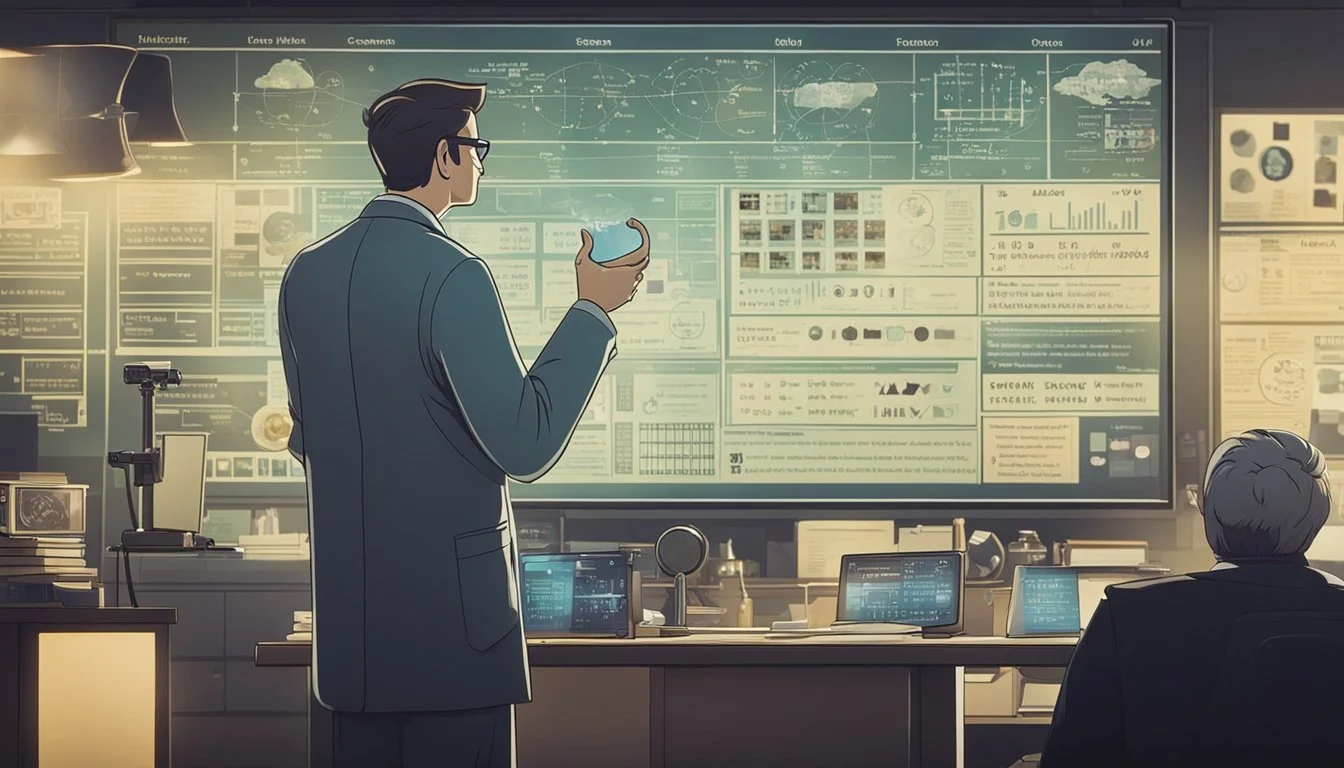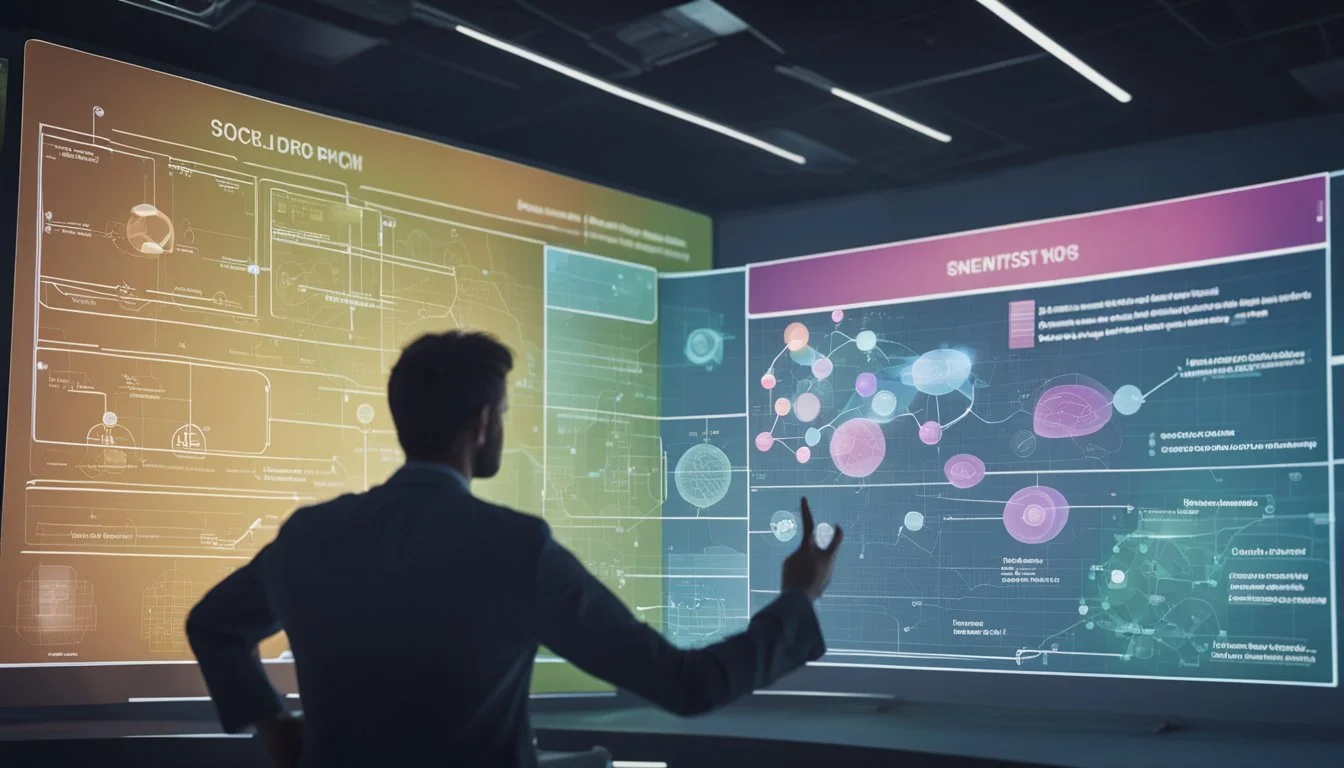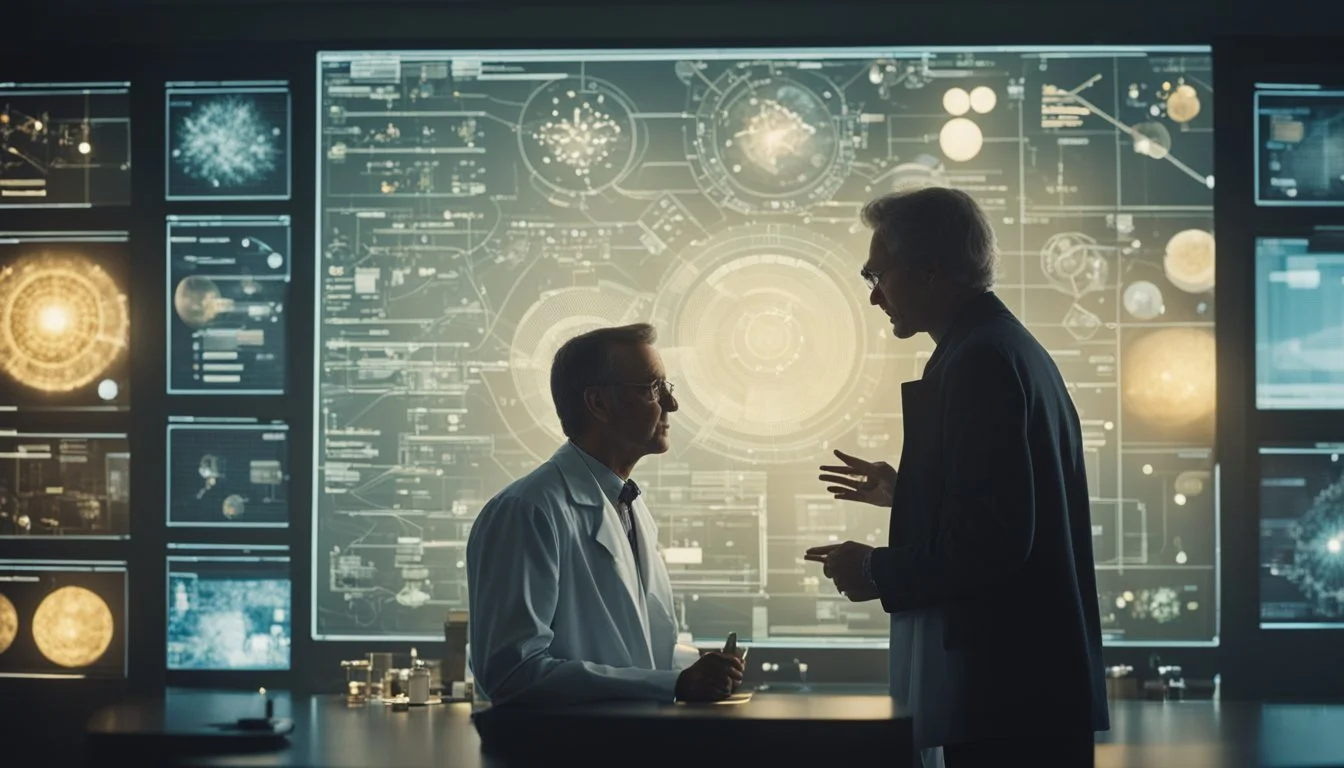The Art of the Scientific Documentary
Simplifying Complex Concepts
As the appetite for scientific knowledge grows, the role of scientific documentaries has become increasingly significant. These documentaries excel at transforming complex scientific concepts into accessible and engaging narratives that captivate viewers of all backgrounds. The human element often highlighted in these films further bridges the gap between intricate theories and everyday understanding.
Documentaries like "Particle Fever" and series such as "Cosmos" showcase how advanced scientific ideas can be presented in visually appealing and intellectually stimulating ways. By profiling the work of scientists and their discoveries, these films reveal the real-world impact of abstract concepts, making them relatable and intriguing.
Educational benefits are a notable aspect of scientific documentaries. They not only entertain but also provide valuable insights into the natural world and technological advancements. The blend of storytelling and factual information in these films fosters a deeper appreciation and comprehension of science, ensuring that even the most complex topics are within reach for a broad audience.
Historical Evolution of Scientific Documentaries
The journey of scientific documentaries began in the early 20th century with short educational films designed for classroom use. These early productions aimed to stimulate interest and understanding in science among students.
In the 1950s and 1960s, television networks started producing science documentaries, bringing topics such as space exploration and natural history into living rooms. Shows like "The Undersea World of Jacques Cousteau" captivated audiences with underwater discoveries.
The 1980s saw a significant shift with the advent of cable channels like Discovery and National Geographic, dedicated to documentary programming. These platforms expanded the scope and reach of scientific documentaries.
The success of series like "Cosmos: A Personal Voyage" by Carl Sagan in 1980 highlighted the potential for blending science education with compelling storytelling. This series set a benchmark for future productions.
In the digital age, the 2000s introduced a new era of high-definition and 3D documentaries. Filmmakers used advanced visual effects and computer-generated imagery (CGI) to visualize complex scientific concepts, making them more accessible and engaging to the audience.
Streaming services like Netflix and Amazon Prime further revolutionized the genre. Documentaries such as "My Octopus Teacher" reached global audiences, showcasing personal and environmental narratives through a scientific lens.
Through the years, scientific documentaries have evolved from simple educational tools to sophisticated visual experiences, making science more accessible to a broader audience.
Understanding the Genre: Defining the Scientific Documentary
Scientific documentaries are a specialized genre that focuses on presenting scientific topics to the public. They often blend education and entertainment to engage a wide audience.
These documentaries cover a range of subjects, from astronomy and biology to cutting-edge technology. They aim to make complex scientific concepts more accessible and understandable.
Filmmakers in this genre often collaborate with scientists and researchers. This ensures accuracy and depth in the information presented.
Key Features of Scientific Documentaries:
In-depth Exploration: Cover detailed scientific theories and experiments.
Expert Interviews: Include insights from scientists and researchers to lend credibility.
Visual Aids: Use animations, graphics, and real footage to illustrate complex concepts.
Scientific documentaries serve as an invaluable resource for both education and inspiration. They provide a window into the world of science, helping viewers appreciate the intricacies of scientific endeavors.
Unlike fictional films, these documentaries strive for a high level of truthfulness. This is achieved through rigorous research and validation of facts.
Traditional Elements:
Narration: A strong narrative thread to guide the viewer through the topic.
Case Studies: Real-world examples to contextualize scientific principles.
Public Engagement: Often encourage viewers to think critically and further explore the topic.
Scientific documentaries have become a crucial tool in science communication. They bridge the gap between scientific communities and the general public.
This genre continues to evolve, utilizing new methods and technologies to better convey information and engage audiences.
The Art of Storytelling in Science
Scientific storytelling is essential for explaining intricate concepts in a more relatable manner. It enhances audience engagement and understanding through structured narratives, character-driven elements, and by highlighting conflicts and resolutions.
Narrative Techniques
Effective scientific documentaries often employ narrative techniques such as chronological storytelling, which helps the audience follow along with the development of scientific discoveries. Flashbacks are also used to provide background and context.
Parallel storylines can illustrate how different research efforts converge towards a unified understanding. Visual aids, like animations and graphics, simplify complex ideas without oversimplifying the science.
Metaphors and analogies are critical in drawing parallels between the scientific concepts and everyday experiences, making them more digestible for the public.
Character Development in Non-Fiction
Character development in scientific documentaries focusses not just on scientists, but also on affected individuals and communities. Their stories humanize the abstract elements of scientific research.
For instance, a documentary might follow a researcher's journey, from hypothesis to experimentation, illustrating their passion and dedication. Adding personal anecdotes and interviews can further embody their struggles and triumphs, making the science more relatable.
Witness stories, such as those from patients or local communities impacted by scientific work, can also elicit empathy and connect with viewers on a personal level.
The Role of Conflict and Resolution
Conflict and resolution are pivotal in keeping viewers engaged and conveying the importance of scientific endeavors. Tension points, like challenges in research, ethical dilemmas, or disputes between scientific theories, create a compelling narrative structure.
Conflict in these contexts often highlights the stakes involved and the rigor of scientific inquiry. The resolution of these conflicts, whether through breakthroughs, collaborations, or new understandings, showcase the scientific method's effectiveness.
By portraying struggles and resolutions, these documentaries not only educate but also inspire, demonstrating how persistent effort in science leads to valuable advancements for society.
Visual and Audio Elements
Effective scientific documentaries leverage both visual and audio elements to convey complex concepts in an engaging and accessible manner. This involves the strategic use of cinematography, music, sound design, animation, and special effects.
Cinematography in Science Communication
Cinematography plays a crucial role by establishing the visual tone and immersing the audience in scientific narratives. It utilizes high-definition footage, slow-motion sequences, and time-lapses to highlight intricate details and processes.
For instance, capturing the bloom of a flower in time-lapse can illustrate biological processes effectively. Drones and underwater cameras now offer unprecedented angles, making natural phenomena more relatable. Shots of researchers in the field also add authenticity and a human touch to the documentaries.
Music and Sound Design
Music and sound design add an emotional layer, enhancing the narrative and making abstract concepts more tangible. Ambient sounds, such as the hum of a laboratory or the rustle of leaves in a forest, ground the viewer in the setting.
Carefully chosen scores can evoke curiosity, excitement, or suspense. Iconic documentaries often use stirring orchestral pieces to underscore the significance of discoveries.
Narration, meanwhile, provides clarity and guides the viewer's understanding, often intertwining with soundscapes to create a compelling auditory experience.
Animation and Special Effects
Animation and special effects clarify and enliven hard-to-visualize scientific phenomena. They break down complex ideas into visually digestible segments.
Animations can depict molecular interactions, astronomical events, or evolutionary processes with precision. Special effects can simulate environments or scenarios impractical or impossible to film, such as the interior of a black hole or chemical reactions at the atomic level.
Tools like CGI bring theoretical concepts to life, making them both engaging and educational. Strategic usage of these elements transforms abstract science into captivating visuals, driving better comprehension among audiences.
Balancing Complexity with Clarity
Balancing complex scientific concepts with clarity in documentaries requires careful simplification, the use of metaphors, and ensuring accuracy. This section discusses practical approaches to achieve this balance effectively.
Simplifying without Oversimplifying
Simplifying complex science without losing essential details is crucial.
Avoiding jargon helps. For example, instead of "neuroplasticity," use "the brain’s ability to change." Replace technical terms with common language where possible.
Key Technique: Break down information into smaller, digestible parts. Use bullet points to list steps or processes.
Example:
Inputs processed by the brain
Formation of new neural connections
Adaptation to new situations
Visual aids like animations can clarify intricate processes. Focus on core ideas and eliminate unnecessary details. This keeps the audience informed without overwhelming them.
The Use of Metaphors and Analogies
Metaphors and analogies enhance understanding.
A black hole can be compared to a vacuum cleaner that sucks up everything nearby. This relatable comparison makes abstract concepts tangible.
Use real-world analogies:
Electricity flow is like water flowing through pipes.
DNA functioning is akin to a computer code.
Supplement these metaphors with visuals to reinforce understanding. Well-chosen analogies make scientific ideas easier to grasp and remember.
Ensuring Accuracy and Credibility
Accuracy is non-negotiable. Misinformation can damage credibility.
Verify information:
Cross-check facts with multiple credible sources.
Peer review by experts enhances reliability.
Cite sources openly to demonstrate credibility. When covering new research, explain uncertainties and ongoing debates. Avoid stretching findings to fit a narrative.
Accuracy doesn’t mean including every detail. Choose what is most relevant and present it truthfully. This builds trust with the audience and ensures the documentary is both engaging and informative.
Engagement and Persuasion Strategies
Effective storytelling is the cornerstone of engaging scientific documentaries. By weaving narratives around complex concepts, filmmakers can capture viewers' attention and make intricate ideas more digestible.
Visual aids, such as animations and diagrams, help in breaking down complicated subjects. These tools offer clarity and retain viewers' interest, facilitating better comprehension of scientific content.
Emotionally charged content fosters deeper connections. Documentaries that incorporate human experiences or emotional narratives are more likely to engage viewers, making the science more relatable.
Interactive elements can be incorporated through digital platforms. Interactive documentaries allow viewers to explore topics at their own pace and delve deeper into areas of interest, boosting engagement.
Balancing logic and emotion is crucial. Presenting scientific data alongside compelling stories ensures that documentaries are both informative and memorable.
Strategy Description Effective storytelling Captures attention by making complex ideas relatable. Visual aids Animations and diagrams clarify and engage. Emotional content Connects viewers through human experiences. Interactive elements Enables exploration and deeper understanding. Balance of logic and emotion Ensures information is both memorable and clear.
By focusing on these strategies, scientific documentaries can transform complex concepts into accessible and engaging content for a wide audience.
Case Studies: Successful Scientific Documentaries
Scientific documentaries play a vital role in demystifying complex topics and making them engaging. This section explores pioneering works, contemporary examples, and their overall impact.
Analysis of Pioneering Works
Early scientific documentaries set the foundation for this genre. Titles like "Cosmos: A Personal Voyage" by Carl Sagan revolutionized how science was communicated. Sagan's ability to combine eloquent narration with stunning visualizations made concepts from astrophysics relatable.
“The Ascent of Man” by Jacob Bronowski also left a significant mark. By tracing the development of human society through scientific advancements, Bronowski provided a cohesive narrative that resonated with audiences, making intricate historical and scientific developments accessible and engaging.
Documentaries such as these have been pivotal in breaking down complex scientific ideas into understandable segments, ensuring that audiences of all backgrounds can grasp and appreciate the importance of scientific discovery.
Contemporary Examples
Modern documentaries continue to build on the legacy of their predecessors, enhancing engagement through advanced filmmaking techniques. “Particle Fever” chronicled the first round of experiments at the Large Hadron Collider. By focusing on the personal stories of the scientists involved, the film humanized abstract concepts from particle physics.
"An Inconvenient Truth" presented by Al Gore, strongly impacted public awareness on climate change. Its success was in its balance of emotional appeal with scientific data, presenting a compelling narrative that spurred global conversations and actions.
Neil deGrasse Tyson's "Cosmos: A Spacetime Odyssey" also stands out for its vibrant visual effects and clear explanations, making it a staple for anyone passionate about science. These modern works highlight the continuous evolution of scientific storytelling and its ability to integrate robust data with compelling narratives.
Impact Assessment
Scientific documentaries significantly impact public understanding and engagement with science. Documentaries like "Blackfish” sparked widespread public debate and policy changes in marine park industries by focusing on the ethical aspects of captive marine life, showing their power in driving real-world change.
Such films not only educate viewers but also influence cultural perceptions and policy decisions. They offer a platform for scientists to communicate directly with the public, bridging the gap between complex scientific research and general knowledge. This genre's ability to both inform and emotionally connect with its audience underlines its unparalleled influence.
Interdisciplinary Collaborations
Interdisciplinary collaborations are pivotal in the creation of scientific documentaries. These partnerships bring together experts from various fields to present complex scientific ideas clearly and engagingly.
Scientists, artists, and writers often collaborate to distill intricate concepts into accessible narratives. This process involves merging scientific accuracy with engaging storytelling.
Diverse perspectives enhance creativity. By integrating various academic disciplines, documentaries can appeal to a broader audience. This can include experts in natural sciences, social sciences, and arts, among others.
Interdisciplinary teams overcome the challenge of representing scientific concepts visually. Graphic artists work with scientists to create visual aids that simplify complex information. This makes the content more engaging and easier to understand.
The collaborative process also fosters innovation. Different fields contribute unique methodologies and insights. This synergy often leads to new ways of visualizing data and presenting information.
Finally, teamwork is essential for translating technical jargon into layman's terms. Writers play a critical role in ensuring that the script is both scientifically accurate and comprehensible to non-experts.
Table 1: Key Roles in Interdisciplinary Collaborations
Role Contribution Scientist Provides expertise and accuracy Graphic Artist Creates visual representations of data Writer Translates complex ideas into accessible text
Examples of successful interdisciplinary efforts can be seen in documentaries that profile scientific heroes and their discoveries. These works often draw on the strengths of multiple disciplines to create a cohesive and engaging narrative.
Ethical Considerations in Scientific Filmmaking
Ethical considerations are crucial in scientific filmmaking. Filmmakers must navigate complex ethical landscapes to ensure responsible and respectful representation of their subjects. This involves maintaining honesty and integrity throughout the production process.
The relationships between filmmakers and their subjects require mutual respect. Transparency about the purpose and potential impact of the documentary is essential. Informed consent, where participants are fully aware and agree to the filming procedures, is mandatory.
Filmmakers often address sensitive topics. They must ensure that their portrayal does not cause harm or misrepresent the subjects or scientific concepts. This requires careful planning and continuous ethical reflection.
In nature documentaries, respect for wildlife and ecosystems is paramount. Filmmakers must avoid disturbing natural behaviors and habitats. "March of the Penguins" is an example where minimal interference ensured ethical standards were upheld.
Human subject documentaries need to protect individual rights and privacy. Collecting data must align with ethical guidelines and protect participants from exploitation. This can involve anonymizing identities and securing sensitive information.
Some projects use filmmaking as a research tool, combining data collection with visual storytelling. Researchers must adhere to scientific and ethical standards, treating participants with dignity and respect throughout their involvement.
Documentary filmmakers have a responsibility to present scientific facts accurately. Misrepresentations can lead to misinformation and public distrust in science. Rigorous fact-checking and consultation with experts help maintain credibility.
Ethics in Editing: The editing process should not distort the truth. Selective editing can mislead audiences, creating false narratives. Ethical editing ensures content remains true to the real events and data.
Summary: Ethical scientific filmmaking balances informative storytelling with respect for subjects and integrity in representation. This responsibility ensures that documentaries educate without harm.
The Future of Scientific Documentaries
Scientific documentaries are evolving through technological advancements, shifting audience perceptions, and the rise of digital platforms. These changes are reshaping the way scientific stories are told and consumed.
Technological Advancements
Modern scientific documentaries benefit greatly from advances in technology. High-definition (HD) and 4K cinematography allow for stunning visuals, making phenomena more tangible and mesmerizing.
Tools like 3D modeling and virtual reality (VR) enable immersive experiences, offering viewers a deeper understanding of complex concepts.
Artificial intelligence (AI) and big data are used to create precise visualizations, bringing abstract theories to life. These innovations enhance storytelling, making documentaries not only more informative but also engaging.
Changes in Audience Perception
Audiences today seek more engaging and transparent content. They favor documentaries that present scientific data in an emotionally resonant way.
There's a growing desire for authenticity and relatability. Viewers prefer narratives that connect with their personal experiences.
The trend of citizen science encourages filmmakers to incorporate public participation, making viewers feel like part of the discovery process. This shift is driving filmmakers to produce content that is both scientifically rigorous and accessible to non-experts.
The Role of Digital Platforms
Digital platforms like YouTube, Netflix, and Amazon Prime have revolutionized the access to scientific documentaries. These platforms offer on-demand viewing, making science content available anytime, anywhere.
Social media integration allows for real-time engagement and feedback, fostering an interactive viewing experience.
Crowdsourcing through platforms like Kickstarter supports independent filmmakers, enabling a diverse range of scientific stories to be told. Digital distribution democratizes the production and viewing process, broadening the reach and impact of scientific documentaries.








